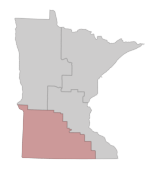
The South Region is made up of 32 counties and includes two of the major ecological provinces, Prairie Parkland and Eastern Broadleaf Forest. This region was historically dominated by native prairie. Prairies were once the largest continuous ecosystem in North America, but today they are one of the continent's most endangered habitats. While much of the region has been converted to agriculture as well as other industries, it retains a variety of rare and unique features. Across the region, you can explore dry hill prairies and rare calcareous fens that boast a unique diversity of wetland plants. Oak woodlands, rock outcrops, savannas, marshes, seepage meadows as well as shallow lakes, wetlands, rivers, and prairie streams are also found throughout the landscape.

Regional highlights

Preserving the prairie landscape
Less than 2% of Minnesota’s original tallgrass prairie remains, so preserving every remnant is important to ensure the survival of prairie and the wildlife, plants, and people who depend on it. Reconstruction (or rebuilding of prairies) is an essential part of prairie stewardship. Regional Ecologists provide expertise and technical assistance for the various stages of reconstruction, conservation, and management efforts on public lands. Ongoing work focuses on linking monitoring results to future management and bringing partners together. One example is the Hole-in-the-Mountain Management and Monitoring project, where partners are working together to improve prairie health and reintroduce a rare prairie butterfly, the federally threatened and state-endangered Dakota skipper.


Photos: Cale Nordmeyer

Photo: Cale Nordmeyer
Prairie Coteau Conservation Focus Area
The Prairie Coteau Conservation Focus Area is a priority conservation area where partners are working with private landowners to implement the Minnesota Wildlife Action Plan and the Minnesota Prairie Conservation Plan. This unique landscape offers a chance to conserve valuable prairie communities and connect these patches with habitat corridors that will help ensure the long-term health of the ecosystem.




Conserving calcareous fens
Calcareous fens are rare and distinctive peat-accumulating wetlands. They are ecologically important wetland communities that support unique wildlife and plants, are good indicators of groundwater sustainability, contribute to improved water quality and ecological diversity, and are an invaluable part of Minnesota’s rich natural heritage. Due to their rarity, they are protected in Minnesota. The best opportunity to experience a fen is to join a guided tour of a Scientific and Natural Area.



Informing solar and wind energy development
As land use continues to change in the south region, the DNR and stakeholders are working together to make the most out of wind and solar energy development. Ecologists provide guidance for these projects to help create habitat for native species within these new developments.


Photos: Cale Nordmeyer

Megan Benage
Regional Ecologist

Genevieve Brand
Assistant Regional Ecologist

